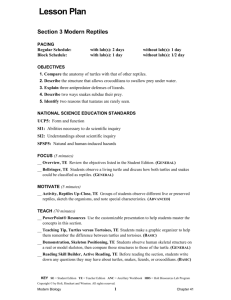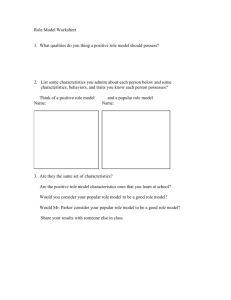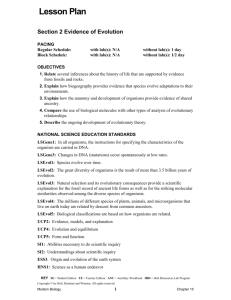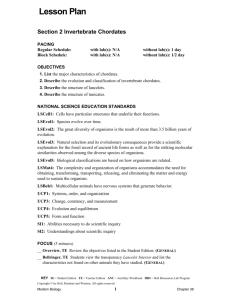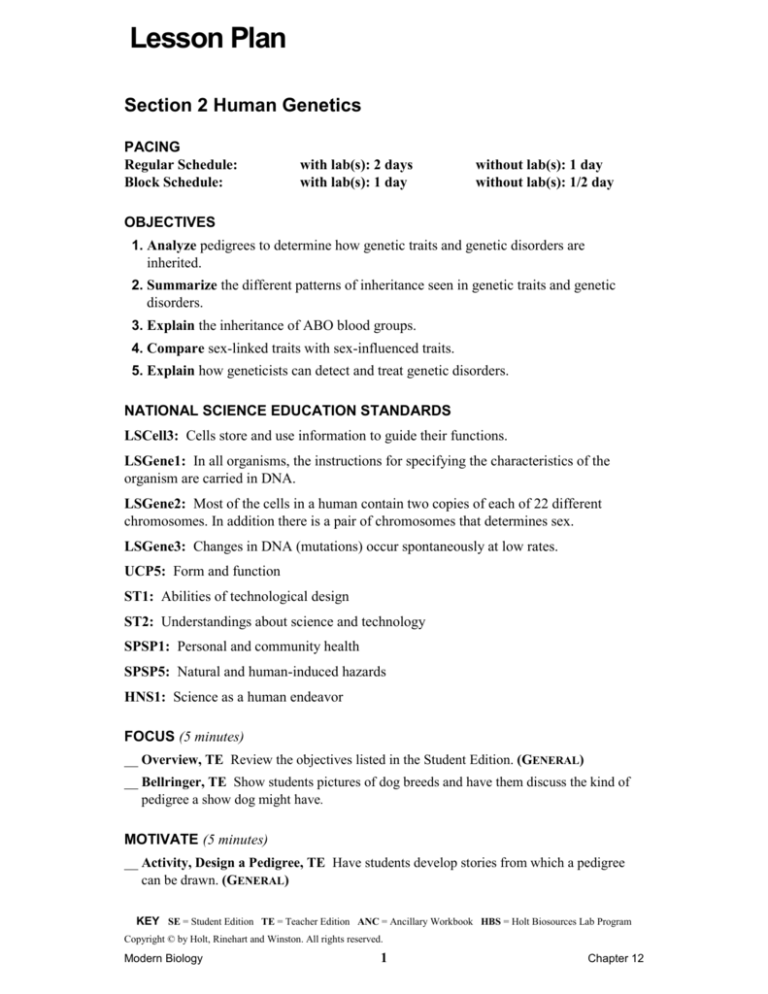
Lesson Plan
Section 2 Human Genetics
PACING
Regular Schedule:
Block Schedule:
with lab(s): 2 days
with lab(s): 1 day
without lab(s): 1 day
without lab(s): 1/2 day
OBJECTIVES
1. Analyze pedigrees to determine how genetic traits and genetic disorders are
inherited.
2. Summarize the different patterns of inheritance seen in genetic traits and genetic
disorders.
3. Explain the inheritance of ABO blood groups.
4. Compare sex-linked traits with sex-influenced traits.
5. Explain how geneticists can detect and treat genetic disorders.
NATIONAL SCIENCE EDUCATION STANDARDS
LSCell3: Cells store and use information to guide their functions.
LSGene1: In all organisms, the instructions for specifying the characteristics of the
organism are carried in DNA.
LSGene2: Most of the cells in a human contain two copies of each of 22 different
chromosomes. In addition there is a pair of chromosomes that determines sex.
LSGene3: Changes in DNA (mutations) occur spontaneously at low rates.
UCP5: Form and function
ST1: Abilities of technological design
ST2: Understandings about science and technology
SPSP1: Personal and community health
SPSP5: Natural and human-induced hazards
HNS1: Science as a human endeavor
FOCUS (5 minutes)
__ Overview, TE Review the objectives listed in the Student Edition. (GENERAL)
__ Bellringer, TE Show students pictures of dog breeds and have them discuss the kind of
pedigree a show dog might have.
MOTIVATE (5 minutes)
__ Activity, Design a Pedigree, TE Have students develop stories from which a pedigree
can be drawn. (GENERAL)
KEY SE = Student Edition TE = Teacher Edition ANC = Ancillary Workbook HBS = Holt Biosources Lab Program
Copyright © by Holt, Rinehart and Winston. All rights reserved.
Modern Biology
1
Chapter 12
Lesson Plan
TEACH (70 minutes)
__ PowerPoint® Resources Use the customizable presentation to help students master the
concepts in this section.
__ Teaching Transparency C27, Tracking Inherited Traits Use this transparency to give
students practice in tracking inherited traits. (GENERAL)
__ Teaching Transparency C28, Pedigree for Cystic Fibrosis Use this transparency to
inform students about the pedigree for cystic fibrosis. (GENERAL)
__ Activity, Designing a Mate, TE Students use a list of characteristics to design a potential
mate and assign a genotype to match the traits selected. (GENERAL)
__ Teaching Tip, Comparing Mutations, TE Students are asked to make a graphic
organizer that compares gene and chromosome mutations. (BASIC)
__ Using the Figure, Polygenic Characters, TE Ask students to list as many different
polygenic characters as possible that they can see in the figure. (GENERAL)
__ Using the Figure, Traits, TE Ask students how they can determine if a trait is recessive
or autosomal. (GENERAL)
__ Demonstration, Litmus-Paper Test, TE Have students relate the color of hydrangea
flowers with a litmus test and explain the different colors of hydrangea. (GENERAL)
__ Teaching Tip, Male Breast Cancer, TE Provide students with statistics on male breast
cancer. (GENERAL)
__ Teaching Tip, Trait Differences, TE Have students compare sex-linked and sexinfluenced traits and give examples of each. (GENERAL)
__ Discussion, Blood Type, TE Ask students to list the possible genotypes of parents who
produce offspring with type O blood. (BASIC)
__ Using the Figure, Seeing Colors, TE Lead students in a discussion of some of the
special problems a color-deficient student might encounter in the classroom. (BASIC)
__ Teaching Transparency C29, Multiple Alleles Use this transparency to explore the
concept of multiple alleles. (GENERAL)
__ Demonstration, Modeling Nondisjuction, TE Students model meiosis I and II for both
normal and nondisjunction gametes. (BASIC)
__ Using the Figure, Fetal Karyotypes, TE Ask students to note the procedural differences
in amniocentesis and chorionic villi sampling. (GENERAL)
__ Discussion, Single-Allele Traits, TE Lead a discussion about why a person might
suspect that he or she could have Huntington’s disease. (GENERAL)
__ Teaching Tip, Huntington’s Origins, TE Students learn about the origins of
Huntington’s disease. (GENERAL)
__ Group Activity, Genetic Disorders, TE Student groups research and share information
on genetic disorders and act as “experts” for the class. (GENERAL)
__ Teaching Tip, Sickle Cell Anemia and Malaria, TE Ask students how sickle cell
anemia might have an adaptive value in Africans. (GENERAL)
KEY SE = Student Edition TE = Teacher Edition ANC = Ancillary Workbook HBS = Holt Biosources Lab Program
Copyright © by Holt, Rinehart and Winston. All rights reserved.
Modern Biology
2
Chapter 12
Lesson Plan
__ Teaching Transparency C30, Some Important Genetic Disorders Use this
transparency to inform students about important genetic disorders. (GENERAL)
__ Group Activity, Making Brochures, TE Students design a brochure about a genetic
disorder. (ADVANCED)
__ Careers in Biology, Genetic Counselor, TE Use this feature to encourage students to
consider careers that require biology skills and knowledge.
__ Teaching Tip, Cystic Fibrosis, TE Discuss the link between the bacterium pseudomonas
aeruginosa and cystic fibrosis. (GENERAL)
__ Skills Practice Lab, Analyzing Karyotypes, SE Students make a human karyotype and
identify whether it is normal or abnormal. (GENERAL)
__ Datasheet for In-Text Labs, Analyzing Karyotypes, ANC Students use the datasheet to
complete the in-text lab. (GENERAL)
CLOSE (10 minutes)
__ Section Review, SE Students are assessed through questions about key concepts and
questions that require critical thinking skills. (GENERAL)
__ Reteaching, TE Given a scenario, students discuss the chances of passing cystic fibrosis
on to offspring. (BASIC)
__ Quiz, TE Students link traits with given genotypic conditions. (GENERAL)
OTHER RESOURCE OPTIONS
__ Active Reading Worksheets, ANC Students are asked to analyze a passage related to the
chapter text and answer questions about the passage. (BASIC)
__ Visual Concepts CD-ROM Use this multimedia resource to reinforce selected concepts
from the chapter.
__ Quick, Data, and Math Labs, Interpreting Information in a Pedigree, HBS Students
learn how to interpret and analyze pedigrees. (BASIC)
__ Quick, Data, and Math Labs, Evaluating a Pedigree, HBS Students practice
interpreting a pedigree. (BASIC)
__ Quick, Data, and Math Labs, Analyzing a Test Cross, HBS Students use a Punnett
square to do a test cross to determine genotypes. (BASIC)
__ Quick, Data, and Math Labs, Identifying Dominant or Recessive Traits, HBS
Students determine some genotypes and all of the phenotypes for some human traits that
are inherited as simple dominant or recessive traits. (BASIC)
KEY SE = Student Edition TE = Teacher Edition ANC = Ancillary Workbook HBS = Holt Biosources Lab Program
Copyright © by Holt, Rinehart and Winston. All rights reserved.
Modern Biology
3
Chapter 12
Lesson Plan
End of Chapter Review and Assessment
PACING
Regular Schedule:
Block Schedule:
with lab(s): N/A
with lab(s): N/A
without lab(s): 2 days
without lab(s): 1 day
__ Alternative Assessment, TE Students work in pairs to organize information about
patterns of heredity into a table. (GENERAL)
__ Study Tip, Sharing Information, TE Students form groups of “note buddies” and
compare notes, outlines and tables. (GENERAL)
__ PowerPoint® Resources Use the customizable presentation to help students practice
standardized test-taking skills.
__ Chapter Highlights, SE Students review the key concepts of the chapter.
__ Chapter Review, SE Students are assessed through vocabulary exercises, questions
about key concepts, and questions that require critical thinking skills.
__ Standardized Test Preparation, SE Assign these questions with a time limit to prepare
students for standardized testing. (GENERAL)
__ Science Skills Worksheet, ANC This worksheet helps reinforce students’ use of basic
science skills. (GENERAL)
__ Study Guide, ANC Use this worksheet to assess student’s understanding of the main
concepts presented in the chapter. (GENERAL)
__ Graphic Organizer Transparency, Use this graphic organizer exercise to help students
analyze the relationships between concepts presented in the chapter. (GENERAL)
__ Concept Mapping Transparency, Use this concept mapping exercise to help students
analyze the relationships between concepts presented in the chapter. (GENERAL)
__ Concept Mapping Transparency Worksheet, Assign the concept mapping transparency
worksheet for students to map the relationships between concepts presented in the chapter.
(GENERAL)
__ Vocabulary Review, ANC Use this worksheet to reinforce vocabulary terms presented in
the chapter. (GENERAL)
__ Critical Thinking Worksheet, ANC This worksheet exercises students’ critical thinking
skills while applying concepts presented in the chapter. (ADVANCED)
__ Quiz, ANC Assign the one-page chapter quiz for a quick chapter assessment. (GENERAL)
__ Chapter Test A, ANC Assign questions from the appropriate test for chapter assessment.
(GENERAL)
__ Chapter Test B, ANC Assign questions from the appropriate test for chapter assessment.
(ADVANCED)
__ Test Generator, Create a customized homework assignment, quiz, or test using the
ExamView® Test Generator.
KEY SE = Student Edition TE = Teacher Edition ANC = Ancillary Workbook HBS = Holt Biosources Lab Program
Copyright © by Holt, Rinehart and Winston. All rights reserved.
Modern Biology
4
Chapter 12
Lesson Plan
__ Test Item Listing, Use the Test Item Listing to identify questions for a customized
homework assignment, quiz, or test.
__ Holt PuzzlePro® Use this software to create crossword puzzles and word searches that
make learning vocabulary fun.
__ Biology Interactive Tutor CD-ROM, Use these interactive activities to give students a
fun way to extend their knowledge of biology concepts.
OTHER RESOURCE OPTIONS
__ Brain Food Video Quizzes, Use these quizzes to help students review the chapter
material.
__ Biotechnology Lab, Extracting DNA, ANC Students separate and collect the DNA from
bovine liver cells. (ADVANCED)
__ Biotechnology Lab, Comparing DNA Samples, ANC Students design an experiment to
compare DNA samples. (ADVANCED)
KEY SE = Student Edition TE = Teacher Edition ANC = Ancillary Workbook HBS = Holt Biosources Lab Program
Copyright © by Holt, Rinehart and Winston. All rights reserved.
Modern Biology
5
Chapter 12


